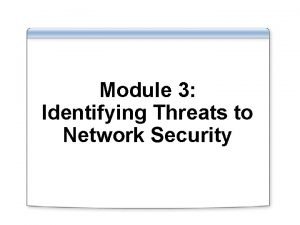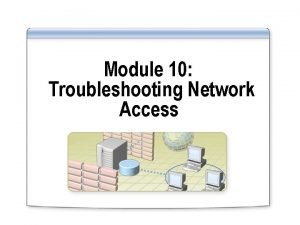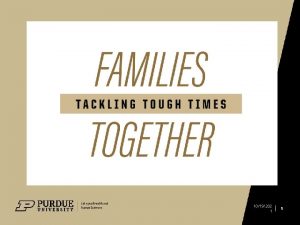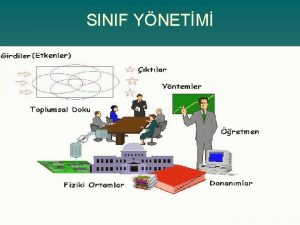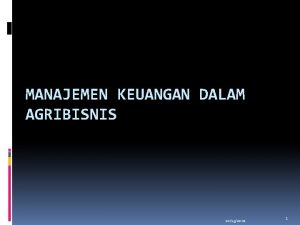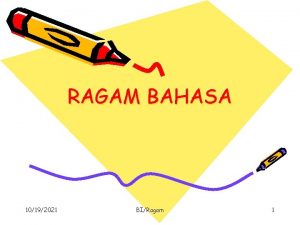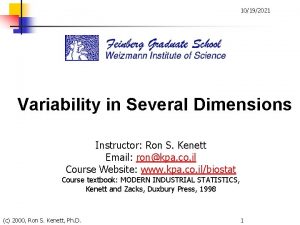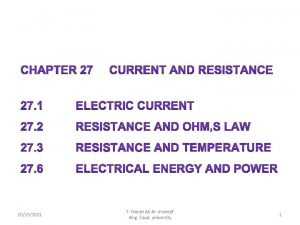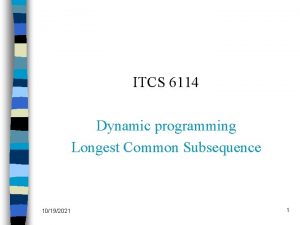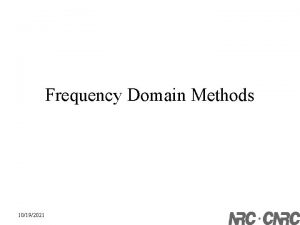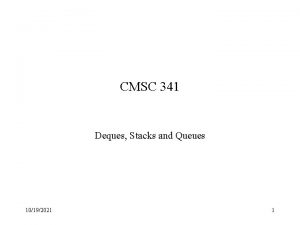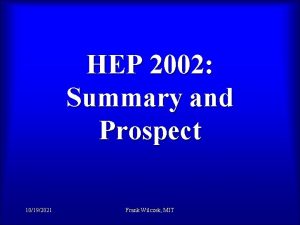Making the Network Module 2 Section 3 10192021





















- Slides: 21

Making the Network Module 2 - Section 3 10/19/2021 1

Introduction This section will cover the following Interface Message Processors (IMPs) Request For Comments (RFC) Network protocols Email 10/19/2021 2

IMPs In a packet switching network, a small computer is inserted between each host and the network of transmission lines These are called IMPs These IMPs are linked together to form a subnetwork of IMPs The IMP acts as the host’s interface to the network That’s why it was called ‘Interface Message Processor’ 10/19/2021 3

IMPs The IMP role Send and receive data Check for errors Route messages Verify that these messages had reached their final destination 10/19/2021 4

IMPs The advantages of this structure are Freeing the host computer from the routing load • Such as dividing the messages into packets • Routing the packets • And assembling packets The routing programs at each site are the same since we have identical routing devices (IMPs) 10/19/2021 5

IMPs The first packet switching network Was built in October 1969 Using 2 IMPs One at UCLA and the other at Stanford Research Institute That network was packet switching IMPs, sending bits between each other 10/19/2021 6

Building the Network In 1968, a group of graduate students from two universities University of California at Los Angels and MIT They set together to discuss what applications would be built on the ARPANET It was called Network Working Group (NWG) 10/19/2021 7

Building the Network They organized a series of meetings They documented their notes and findings Called them Request for Comments (RFC) RFCs are technical notes written by the NWG To exchange ideas on the design of host software for the ARPANET 10/19/2021 8

Building the Network RFC documents are very important because They promoted cooperative and open work methods They are timely documents, containing information that comprise the consensus of the network developers • They were tested through the process of peer-review • Errors were quickly discovered and remedied Today, the RFCs present an accurate trace on how Internet software evolved 10/19/2021 9

Evolving the Network Protocols The networking group used RFCs to evolve a whole set of protocols for the new network The key persons for protocol development Vint Cerf Jon Postel Steve Crocker A protocol is a set of rules (standards) 10/19/2021 10

Evolving the Network Protocols Main functions of Network protocol are Provide rules that govern how the computers communicate and interact Give exact meaning to the bits flowing between the IMPs Concerned with passing messages Specify the format that a message must take, and the way in which computers must exchange a message within the context of a particular activities • Such as exchanging e-mail, establishing remote connections or transferring files 10/19/2021 11

Protocols- what they do and why they matter Some of the protocols used on the Internet are Simple Mail Transfer Protocol (SMTP) • used to send and receive electronic Mail File Transfer Protocol (FTP) • used to transfer files between computers Hyper Text Transfer Protocol (HTTP) • used to transmit information on the world wide web Network News Transfer Protocol ( NNTP) • used to transmit network (Usenet) news 10/19/2021 12

Protocols- what they do and why they matter Internet protocols are much more complex than its predecessor, the ARPANET Network Control Protocol (NCP) created by Network Working Group (NWG) enabled different hosts on the network to communicate Two protocols developed in early days Telnet: used for logging into remote hosts FTP: used for secure transfer of files between hosts 10/19/2021 13

Protocol layers Communication via computers involves many processes at different levels (layers) from passing signals down cables or over wireless (satellite or microwave) or fiber-optic links to formatting messages Protocols that are used to deal with all these different levels are defined in the table below 10/19/2021 14

Protocol layers Layer Name What goes on in this layer Typical protocols Application E-mail formatting, file transfer, remote login, etc. FTP, Telnet, SMTP Transport Breaking messages into packets, routing messages TCP Internet Assigning and resolving Internet addresses IP Sub network Passing packets round a local area network on their way to an Internet router Ethernet Link Setting up a connection between the transmitting computer and the Internet (e. g. by dial-up modem) PPP, SLIP Physical The medium which carries the signals RS 232 (serial cable) 10 Base. T (Ethernet) Fiber optic, etc. 10/19/2021 15

Protocol layers This layered architecture is different than the regular network layered architecture Which consists of 7 layers 10/19/2021 16

10/19/2021 17

The birth of e-mail One of the most important application that was developed on the ARPANET was email in 1970 Email was a method of machine-to-machine message exchange Ray Tomlinson (a hacker) had written the first email program He was the first person, who used the symbol “@” to separate the sender’s name from the network ID 10/19/2021 18

The birth of e-mail In 1973, ARPANET community formalized an email protocol In 1975, A revised email protocol has been introduced in RFC 680 “Message Transmission protocol” In 1977, the email protocol was revised and remained unchanged since then 10/19/2021 19

The birth of e-mail Since its production in 1973, three quarters of the network traffic was for email because It is a fast way of communicating informal message Messages are easily composed with the help of email clients and delivered instantly to the addressee 10/19/2021 20

Summary IMPs and the design on the first network Network protocols The Network Working Group RFCs E-mail – styles and protocols Read chapters: 5, 8 and 9 from the book: “A brief history of the future” 10/19/2021 21
 C device module module 1
C device module module 1 What is inference
What is inference War making and state making as organized crime summary
War making and state making as organized crime summary Module 3: information and network security
Module 3: information and network security Logon process ias
Logon process ias Hình ảnh bộ gõ cơ thể búng tay
Hình ảnh bộ gõ cơ thể búng tay Slidetodoc
Slidetodoc Bổ thể
Bổ thể Tỉ lệ cơ thể trẻ em
Tỉ lệ cơ thể trẻ em Voi kéo gỗ như thế nào
Voi kéo gỗ như thế nào Tư thế worm breton là gì
Tư thế worm breton là gì Chúa sống lại
Chúa sống lại Các môn thể thao bắt đầu bằng tiếng đua
Các môn thể thao bắt đầu bằng tiếng đua Thế nào là hệ số cao nhất
Thế nào là hệ số cao nhất Các châu lục và đại dương trên thế giới
Các châu lục và đại dương trên thế giới Công thức tính độ biến thiên đông lượng
Công thức tính độ biến thiên đông lượng Trời xanh đây là của chúng ta thể thơ
Trời xanh đây là của chúng ta thể thơ Mật thư tọa độ 5x5
Mật thư tọa độ 5x5 Làm thế nào để 102-1=99
Làm thế nào để 102-1=99 độ dài liên kết
độ dài liên kết Các châu lục và đại dương trên thế giới
Các châu lục và đại dương trên thế giới Thơ thất ngôn tứ tuyệt đường luật
Thơ thất ngôn tứ tuyệt đường luật



